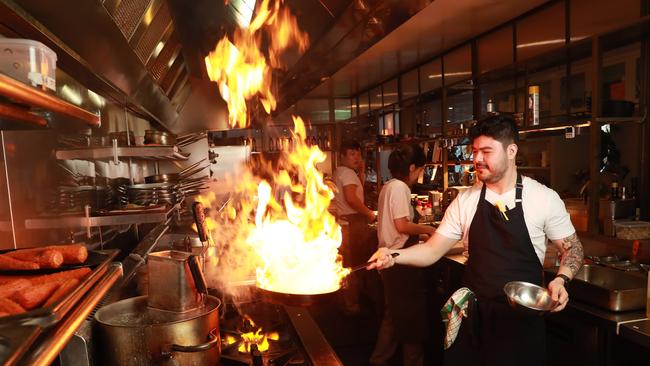Who will wear rising food costs? It won’t be the supermarkets
Little-known fish species are back on the menu. Families are turning to frozen foods. Everyone is grappling with rising prices.

The gurnard is an odd-looking red fish described by one unsympathetic researcher as “a major component of trawl-bycatch”.
Last week, it made its way onto the menu of Hotel Centennial – a swish establishment in Sydney’s eastern suburbs better known for serving caviar waffles.
The gurnard is part of the restaurant’s attempt to fight grinding inflation and supply chain issues causing no end in grief for the restaurant industry more broadly.
The pub – one of a string in the Hemmes family’s Merivale hospitality empire – has seen large rises in food costs. Cooking oil is up 75 per cent, wagyu by 20 per cent, and other beef about 10 per cent.
Ben Greeno, Merivale executive chef, said the kitchen had decided to try new things – and keep costs under control.
“It’s great to challenge the chefs and keep the team interested,” he said. “We are alway trying to do something interesting with these items, like gurnard.”
The new additions to the menu are also keeping a lid on some of the prices charged to diners.
Who wears the impact of rising food costs is a vexed question, not just in the restaurant, but among families, food suppliers and supermarket chains across the country.
So who will take the loss when the price of producing food rises? Hint: it’s not necessarily your friendly supermarket behemoth that claims to be capping the price of staple food products.
And things are likely to get worse before they improve. Inflation figures for the three months to June 30 – to be released on Wednesday – are forecast to come in at 6.3 per cent, a rise from the 5.1 per cent earlier this year.
Earlier this year, Coles and Woolworths said they would attempt to limit increases in grocery costs passed on to consumers.
But with the supermarkets to unveil their financial results for the year in August, few in the market expect them to show the companies have absorbed the costs – despite the clever marketing.
Paul Xiradis is the chairman of Ausbil, an investment house with some $15.5bn under management and a Woolworths shareholder.
He expects margins at Woolworths be maintained – at a minimum – or more likely rise as it recovers from a pandemic-related rise in expenses recorded in earlier financial results.
“They will be maintained or expand a bit,” said Mr Xiradis. “Supermarkets should fare better than food producers because the cost of goods can be passed on, and are being passed on.”
Indeed, in a catchily-titled note “robbing Peter to pay Paul” the research team at Jefferies shrugged off any idea that Woolworths’ announced price freezes on a basket of essential items were of concern to the company’s profits.
“We aren’t concerned. Channel checks suggest supermarkets have more than recovered inflation through higher shelf price and Woolworths has lifted price by more than Coles,” said Jefferies analyst Michael Simotas in the note sent to the investment bank’s clients. “Some products in the programme have likely already seen price increases and while there may be some cost, it has likely been funded by price increases on other products.”

Australian Bureau of Statistics data for March showed food inflation was up 4.3 per cent compared to a year ago, with the biggest jump being fresh vegetables and meat – at 6.7 per cent and 6.2 per cent respectively.
Mr Xiradis believes that Woolworths and Coles will benefit from people needing to count their costs because people will reconsider restaurant bookings and be more inclined to buy the supermarkets’ own white-labelled products. “When times get a bit tougher, people tighten their belts. They will be going out less and spending more through grocery stores … and there are better margins for the retailers through the house brands,” Mr Xiradis said.
So if costs are rising, and it isn’t affecting supermarket profit, who is taking the financial hit?
Morco Fresh is a major fresh produce supplier. The company’s chairman, Paul Moraitis, says the answer to the question on who is having to wear these skyrocketing prices, is that everyone along the food chain from grower to consumer is likely to have to carry some extra cost.
“It’s a bit of everyone having to pay,” said Mr Moraitis. “What we need to think about now is what the new normal will look like. From the growers perspective, there are issues with availability of staff, staff that are sick, the price of fertilisers and fuel rising. What will this normal be now?”
Mr Moraitis says the ability of fresh food producers to pass on costs depends on what they grow, with some locked into tendered contracts and others working on floating prices.
The worry for farmers is that not only are their costs going up significantly, demand is dropping as consumers look for cheaper items. “Demand has declined and I think there is a massive swing to the frozen section for produce,” Mr Moraitis predicts.
Lettuce grower Marion Ellyard has seen the drop in demand first-hand as prices have risen.
“These cost increases have to filter down to the consumer and we’ve seen a decrease in demand of 10-20 per cent in the last three months,” Ms Ellyard said.
Further challenging the situation, her farm The Gourmet Salad Hut, has had to purchase up to a year’s worth of fertilisers in advance – rather than just two to four weeks ahead of time – because supply has become so uncertain and prices risen so much.
“These are huge expenses for us,” she said. “The costs are too high and now there’s just too much risk.”
Ms Ellyard says fertiliser and pesticide costs have doubled, and container delivery costs have risen from $5,000 to $11,000.
“We have no choice but to pass these costs down,” she added.
How this is reflected will be known when the ABS releases its latest inflation data.
What it will probably show is claims by the supermarkets that they are keeping prices down on staple food products are not much more than an unaccountable marketing exercise.
As one banker said, it’s pretty unlikely that Coles and Woolworths are likely to open their books to show they are absorbing losses across key food groups.
“I think it’s a goodwill gesture, which will be honoured where they can,” the banker said.
From an investor perspective, this is probably good news for Woolworths and Coles shareholders, and less good news for owners of food producers.
“Our discussions with industry participants have suggested the supermarket industry has generally been lifting shelf prices by a larger amount than the wholesale increases from suppliers,” wrote Mr Simotas of Jefferies. “This should have underpinned increased product gross margins.”
The investment bank has recommended clients buy shares in both Coles and Woolworths.
The combination of rent hikes, rising interest rates, skyrocketing energy prices and now a big jump in the cost of food is creating a perfect storm for many Australians, who are probably all going to have to dig deeper to pay their bills.




